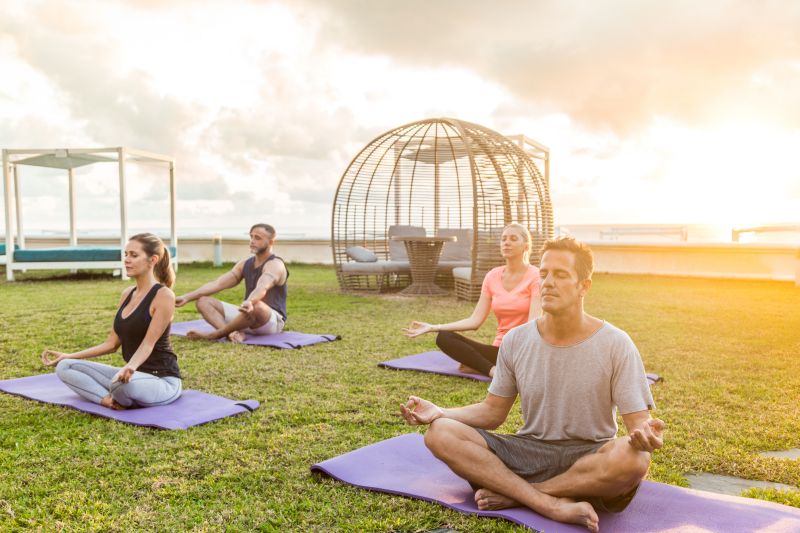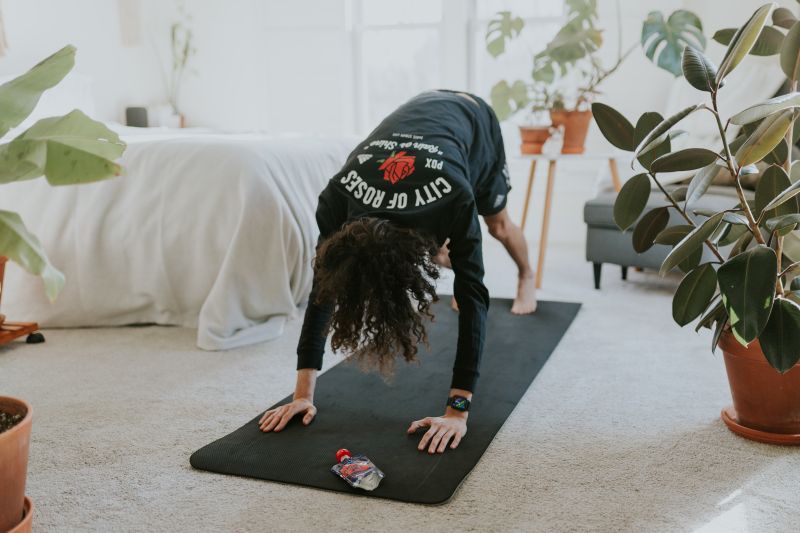Mind-Body Connection: How to Use Exercise to Improve Your Mental and Emotional Health
Exercise is a top-tier approach to uplifting one's mental and emotional health. It is known to help manage stress and anxiety. It can also lower blood pressure and improve well-being. But, one must remain vigilant of potential pitfalls before commencing a workout routine. Let's discuss the benefits of physical activity for the mind and body.
Physical activity might be as beneficial as antidepressants or psychological therapies. Exercise benefits go beyond increased muscle mass and cardio fitness. You may reduce your waistline, and add years to your life. You can improve your physical health and body with exercise. Yet, most individuals aren't motivated to continue being active by that.
Most people who exercise do so because it makes them feel great. They experience higher memory recall. They have better sleep at night and more vitality during the day. They also feel more at ease and optimistic about their lives and themselves. It's also a potent treatment for various widespread mental health issues.
Exercise and Mental Health
People who are not familiar with regular physical activity often wonder about its benefits for mental health. The good news is that one can soon see changes in their mood and cognitive function. Studies have revealed that you can observe a favorable impact. Regardless of the level of exercise, whether low or moderate intensity.
Adults should exercise most days of the week to get 2.5–5 hours of moderate physical activity. For example, brisk walking or swimming. 1.25–2.5 hours of intense physical activity, like jogging, fast cycling, or playing team sports. Or, one can blend vigorous and moderate physical exercise for the best outcomes.
Depression and Anxiety: Exercise has been shown to improve mood. It’s because it reduces the signs of anxiety and despair. Endorphins are the body's well-known "feel good" hormones, generated by the brain and spinal cord. It handles the emotions of joy and pleasure, which are increased by physical exercise. Some physicians advise exercising for these disorders before taking medicine. It's because even modest weekly activity might reduce sadness and anxiety.

Exercise and Emotional Health
Regular physical activity is a tactic to diminish anxiety and improve cognitive well-being. Its efficacy is underpinned by the production of naturally occurring painkillers called endorphins. The neurotransmitter serotonin helps reduce feelings of hopelessness and unease. This composition expounds on the physiological and mental impacts of regular exercise.
Endorphins augment the synthesis of dopamine, a neurotransmitter that regulates emotions. Additionally, they reduce stress levels. Eating chocolate triggers dopamine, generating satisfaction, pleasure, and gratification. These rewarding activities stimulate the release of dopamine.
Regular physical activity is a commendable approach to amplifying serotonin secretion. It facilitates cognitive clarity and augments information processing efficacy. Food rich in protein has been proven to heighten the potential to produce serotonin.
Types of Exercise
Many exercises, including running, walking, and yoga, improve mental and emotional health. Let's do these exercises one by one:
Running
One of the most admired physical activities that may combine physical health and mental wellness is running. It is completely free, can be done outside, and, like walking, has the extra benefit of being an exercise. It can be easily transferred to the gym by stepping onto the treadmill.
When someone runs, mood-enhancing endorphins combine with the "runner high" they experience afterward. It results in an improved sensation of well-being and, in some circumstances, a moderate state of pleasure. Additionally, runners are known to laud the virtues of stress relaxation and improved sleep.
Yoga
Yoga has its foundation in spirituality. It is linked to practices like meditation and intentional breathing. These practices are synonymous with calmness and peace. The benefits of yoga have made it a widely acclaimed therapeutic practice tool. Yoga heightens awareness, reduces stress, and eases muscular tension. Moreover, it is a soothing exercise that enables one to focus entirely on oneself and their body. It clarifies why individuals regularly bask in the psychological health benefits of yoga.
It is vital to remember that several varieties of yoga offer a spectrum of classes. These classes range from completely calming and meditative to more physically demanding options. You can experiment with different styles until you discover the ideal one that suits your requirements.

Walking
Walking, though seemingly easy, is a great fitness activity. It's a free, low-impact activity that lets you breathe fresh air.
Remember that exercise does not have to be strenuous or take an hour to benefit one's well-being. Walking can be divided into reasonable doses throughout the day for people who need a more manageable schedule.
Another remarkable quality of walking is that it can be increased in intensity according to one's preference. An amble can be a gateway into this activity for beginners or those with physical limitations. As you become more accustomed to walking, you can gradually increase your pace or try walking on hilly terrain. This will result in both mental and physical benefits.
Mindfulness and Exercise
Mindfulness constitutes a type of contemplative praxis. It involves focusing on your immediate present occurrences. This mental workout incorporates diverse methods. Such as controlled respiration, directed visualization, and other relaxation maneuvers. It eases both the psyche and soma, thereby reducing the frequency of stress.
Assemble your attention toward the matter at hand. Concentrate on your senses: sight, sound, smell, taste, and touch. Notice the sensation of water flowing through your skin while you shower intensely. If your mind wanders, which is its natural tendency, observe the direction of your thoughts. Some individuals may find identifying and acknowledging their emotions and thoughts beneficial.
Stay alert and receptive. Be conscious of the emotions and physical sensations you are experiencing. You don't need to try to get rid of any thoughts or feelings. Instead, try to observe and acknowledge them with friendly curiosity. Avoid making judgments about them.

The Importance of Rest and Recovery
Rest and recovery are crucial for improving mental and emotional well-being. You can do it via exercise and its physical effects. It improves blood flow, which aids in the removal of waste from soft tissue that has been damaged by strenuous activity. The nutrients that help rebuild and repair muscles, tendons, and ligaments are then carried by fresh blood flow. Mental relaxation and recovery are also vital for mental regeneration. Hobbies that take you away from training, your job, and other responsibilities can prevent mental burnout.
When you exercise, your muscles become worn out or exhausted, which causes slight muscular damage. There are changes in hormones and enzymes, and inflammation increases. These changes result in increased muscle growth, lower body fat, and higher insulin sensitivity. It also results in lessened inflammation, enhanced cardiovascular wellness, and healthier bodies.
However, give your body time to modify before exerting it again. Most athletes know adequate recovery following training is necessary for optimal performance. But many individuals feel guilty about taking a day off. This guilt will lessen as you realize the benefits of taking a day off.
Exercise as Self-Care
Exercise may lift your spirits, give you more energy, and possibly lengthen your life. Considering practice has such substantial benefits for practically all aspects of health. Including mental health, turning it into a pill would create a multi-million-dollar market. Aim for at least 30 minutes of physical exercise daily as a general objective. If you already follow a regular fitness regimen, continue to do so. And pat yourself on the back for practicing such effective prevention.
Regular exercise may increase your cardiovascular system's performance. It distributes oxygen and nutrients to your tissues. And it increases your muscular strength and increases your endurance. You have more energy for everyday tasks when your heart and lungs function more effectively. Regular exercise might help you fall asleep more and sleep deeper if you have trouble. Try exercising earlier to give yourself time to unwind before bed.
Exercise gives you more energy, makes you happier, and makes you feel better about your body, which may improve your life. A good technique for practicing self-care is to include exercise in your daily routine. This might entail doing fun and doable physical exercise, such as going for a stroll, doing yoga, or playing a team sport.
Finding a sustainable and pleasurable kind of exercise is crucial since the self-care benefits of exercise depend on regularity. A healthcare practitioner should also be consulted to identify the best fitness program based on each person's unique needs and objectives. Exercise is a straightforward yet powerful self-care practice that may help one prioritize and enhance both physical and emotional well-being.

Conclusion
Exercise has been shown to have many benefits for mental and emotional health. Studies have found that regular exercise can reduce symptoms of anxiety and depression. It improves mood, increases self-esteem, and enhances cognitive function. Thus, it is important to incorporate exercise into our daily routines to improve our overall well-being. Share your experiences with exercise and mental health in the comments section below. Sharing personal stories can help inspire and motivate others. It helps them to take action and improve their mental and emotional well-being.


